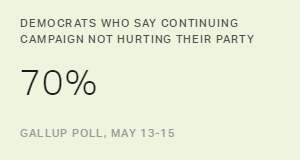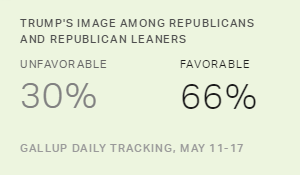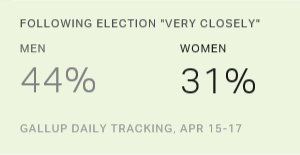Story Highlights
- 47% of Republicans, 39% of Democrats following election news very closely
- General GOP advantage on this measure evident each month since January
- Overall, Americans paying slightly more attention now than in January
PRINCETON, N.J. -- Republicans continue to follow the news of the presidential election more closely than Democrats. In mid-May, 47% of Republicans and Republican-leaning independents say they are following election news "very closely," compared with 39% of Democrats and Democratic leaners. This eight-percentage-point gap is slightly smaller than in previous months, but the general pattern of Republicans paying closer attention than Democrats has been evident all year.

This measure of attention paid to the campaign is based on Gallup Daily tracking interviews conducted in the middle of each month since January, with the latest update from May 13-15.
That Republicans pay closer attention to elections is not a new phenomenon; the basic pattern was evident in the 2012 presidential election. Additionally, some real-world evidence -- namely, higher television ratings for the Republican than for the Democratic presidential debates last fall and earlier this year -- underscores the sense that the GOP primary process has been more engaging than the Democratic process for Americans. This may reflect the unusually large field of 17 GOP candidates, the presence of the iconoclastic Donald Trump, and greater uncertainty about who would ultimately prevail in the Republican race.
The groups paying the closest attention to the election generally are those most likely to identify as Republicans. These include men, those aged 50 and older, and whites.
| Very closely | |||||||||||||||||||||||||||||||||||||||||||||||||||||||||||||||||||||||||||||||||||||||||||||||||||
|---|---|---|---|---|---|---|---|---|---|---|---|---|---|---|---|---|---|---|---|---|---|---|---|---|---|---|---|---|---|---|---|---|---|---|---|---|---|---|---|---|---|---|---|---|---|---|---|---|---|---|---|---|---|---|---|---|---|---|---|---|---|---|---|---|---|---|---|---|---|---|---|---|---|---|---|---|---|---|---|---|---|---|---|---|---|---|---|---|---|---|---|---|---|---|---|---|---|---|---|
| % | |||||||||||||||||||||||||||||||||||||||||||||||||||||||||||||||||||||||||||||||||||||||||||||||||||
| NATIONAL ADULTS | 40 | ||||||||||||||||||||||||||||||||||||||||||||||||||||||||||||||||||||||||||||||||||||||||||||||||||
| GENDER | |||||||||||||||||||||||||||||||||||||||||||||||||||||||||||||||||||||||||||||||||||||||||||||||||||
| Male | 43 | ||||||||||||||||||||||||||||||||||||||||||||||||||||||||||||||||||||||||||||||||||||||||||||||||||
| Female | 37 | ||||||||||||||||||||||||||||||||||||||||||||||||||||||||||||||||||||||||||||||||||||||||||||||||||
| AGE | |||||||||||||||||||||||||||||||||||||||||||||||||||||||||||||||||||||||||||||||||||||||||||||||||||
| 18 to 29 | 26 | ||||||||||||||||||||||||||||||||||||||||||||||||||||||||||||||||||||||||||||||||||||||||||||||||||
| 30 to 49 | 32 | ||||||||||||||||||||||||||||||||||||||||||||||||||||||||||||||||||||||||||||||||||||||||||||||||||
| 50 to 64 | 51 | ||||||||||||||||||||||||||||||||||||||||||||||||||||||||||||||||||||||||||||||||||||||||||||||||||
| 65+ | 51 | ||||||||||||||||||||||||||||||||||||||||||||||||||||||||||||||||||||||||||||||||||||||||||||||||||
| EDUCATION | |||||||||||||||||||||||||||||||||||||||||||||||||||||||||||||||||||||||||||||||||||||||||||||||||||
| H.S. or less | 31 | ||||||||||||||||||||||||||||||||||||||||||||||||||||||||||||||||||||||||||||||||||||||||||||||||||
| Some college | 41 | ||||||||||||||||||||||||||||||||||||||||||||||||||||||||||||||||||||||||||||||||||||||||||||||||||
| College grad only | 48 | ||||||||||||||||||||||||||||||||||||||||||||||||||||||||||||||||||||||||||||||||||||||||||||||||||
| Postgraduate | 55 | ||||||||||||||||||||||||||||||||||||||||||||||||||||||||||||||||||||||||||||||||||||||||||||||||||
| RACE | |||||||||||||||||||||||||||||||||||||||||||||||||||||||||||||||||||||||||||||||||||||||||||||||||||
| Whites | 45 | ||||||||||||||||||||||||||||||||||||||||||||||||||||||||||||||||||||||||||||||||||||||||||||||||||
| Nonwhites | 27 | ||||||||||||||||||||||||||||||||||||||||||||||||||||||||||||||||||||||||||||||||||||||||||||||||||
| IDEOLOGY | |||||||||||||||||||||||||||||||||||||||||||||||||||||||||||||||||||||||||||||||||||||||||||||||||||
| Conservative | 45 | ||||||||||||||||||||||||||||||||||||||||||||||||||||||||||||||||||||||||||||||||||||||||||||||||||
| Moderate | 35 | ||||||||||||||||||||||||||||||||||||||||||||||||||||||||||||||||||||||||||||||||||||||||||||||||||
| Liberal | 40 | ||||||||||||||||||||||||||||||||||||||||||||||||||||||||||||||||||||||||||||||||||||||||||||||||||
| Gallup, May 13-15, 2016 | |||||||||||||||||||||||||||||||||||||||||||||||||||||||||||||||||||||||||||||||||||||||||||||||||||
A Gallup analysis last month noted that the gender gap in paying attention to the election had been growing since February, with men 13 points more likely than women to be paying very close attention. This month, however, that gap has narrowed, although men continue to be paying closer attention than women.
Americans' Interest in the Election Rises Gradually Since January
American adults overall are paying slightly more attention to the presidential election as the primary season has gone on this year, although there has been little meaningful change in the percentage following "very closely" over the past three months. Forty percent are following election news very closely in May, up from 31% in January. More broadly, 79% report following news about the election very or somewhat closely now, compared with 69% in January. This leaves 21% who are following election news not too closely or not at all.
| January% | February% | March% | April% | May% | |||||||||||||||||||||||||||||||||||||||||||||||||||||||||||||||||||||||||||||||||||||||||||||||
|---|---|---|---|---|---|---|---|---|---|---|---|---|---|---|---|---|---|---|---|---|---|---|---|---|---|---|---|---|---|---|---|---|---|---|---|---|---|---|---|---|---|---|---|---|---|---|---|---|---|---|---|---|---|---|---|---|---|---|---|---|---|---|---|---|---|---|---|---|---|---|---|---|---|---|---|---|---|---|---|---|---|---|---|---|---|---|---|---|---|---|---|---|---|---|---|---|---|---|---|
| Following closely (net) | 69 | 71 | 75 | 75 | 79 | ||||||||||||||||||||||||||||||||||||||||||||||||||||||||||||||||||||||||||||||||||||||||||||||
| Very closely | 31 | 34 | 40 | 37 | 40 | ||||||||||||||||||||||||||||||||||||||||||||||||||||||||||||||||||||||||||||||||||||||||||||||
| Somewhat closely | 38 | 37 | 35 | 38 | 39 | ||||||||||||||||||||||||||||||||||||||||||||||||||||||||||||||||||||||||||||||||||||||||||||||
| Following not too closely or not at all | 30 | 29 | 25 | 24 | 21 | ||||||||||||||||||||||||||||||||||||||||||||||||||||||||||||||||||||||||||||||||||||||||||||||
| Gallup | |||||||||||||||||||||||||||||||||||||||||||||||||||||||||||||||||||||||||||||||||||||||||||||||||||
Implications
Although Republicans have been consistently more likely than Democrats to say they are following election news closely this year, more activity is left in the race for the Democratic nomination than for the GOP nomination, which appears to be settled. How this might affect the attention gap remains to be seen.
More broadly, attention to the election will most likely rise for all Americans in July, as the two parties hold their conventions, and then again in September and October, as the campaign comes down to its final two months. The latter period will include four planned debates, the first of which is scheduled for Sept. 26 at Wright State University in Dayton, Ohio. Whether the Democrats can generate more interest from their constituency and hence increase the probability of higher voter turnout is one of their central challenges moving toward November.
Historical data are available in Gallup Analytics.
Survey Methods
Results for this Gallup poll are based on telephone interviews conducted May 13-15, 2016, on the Gallup U.S. Daily survey, with a random sample of 1,537 adults, aged 18 and older, living in all 50 U.S. states and the District of Columbia. For results based on the total sample of national adults, the margin of sampling error is ±3 percentage points at the 95% confidence level. For results based on the total samples of 699 Democrats and Democratic-leaning independents and 677 Republicans and Republican-leaning independents, the margin of sampling error is ±5 percentage points at the 95% confidence level. All reported margins of sampling error include computed design effects for weighting.
Each sample of national adults includes a minimum quota of 60% cellphone respondents and 40% landline respondents, with additional minimum quotas by time zone within region. Landline and cellular telephone numbers are selected using random-digit-dial methods.
Learn more about how the Gallup U.S. Daily works.


